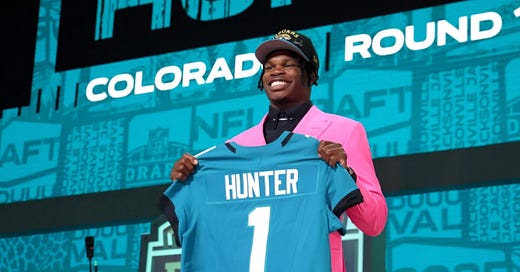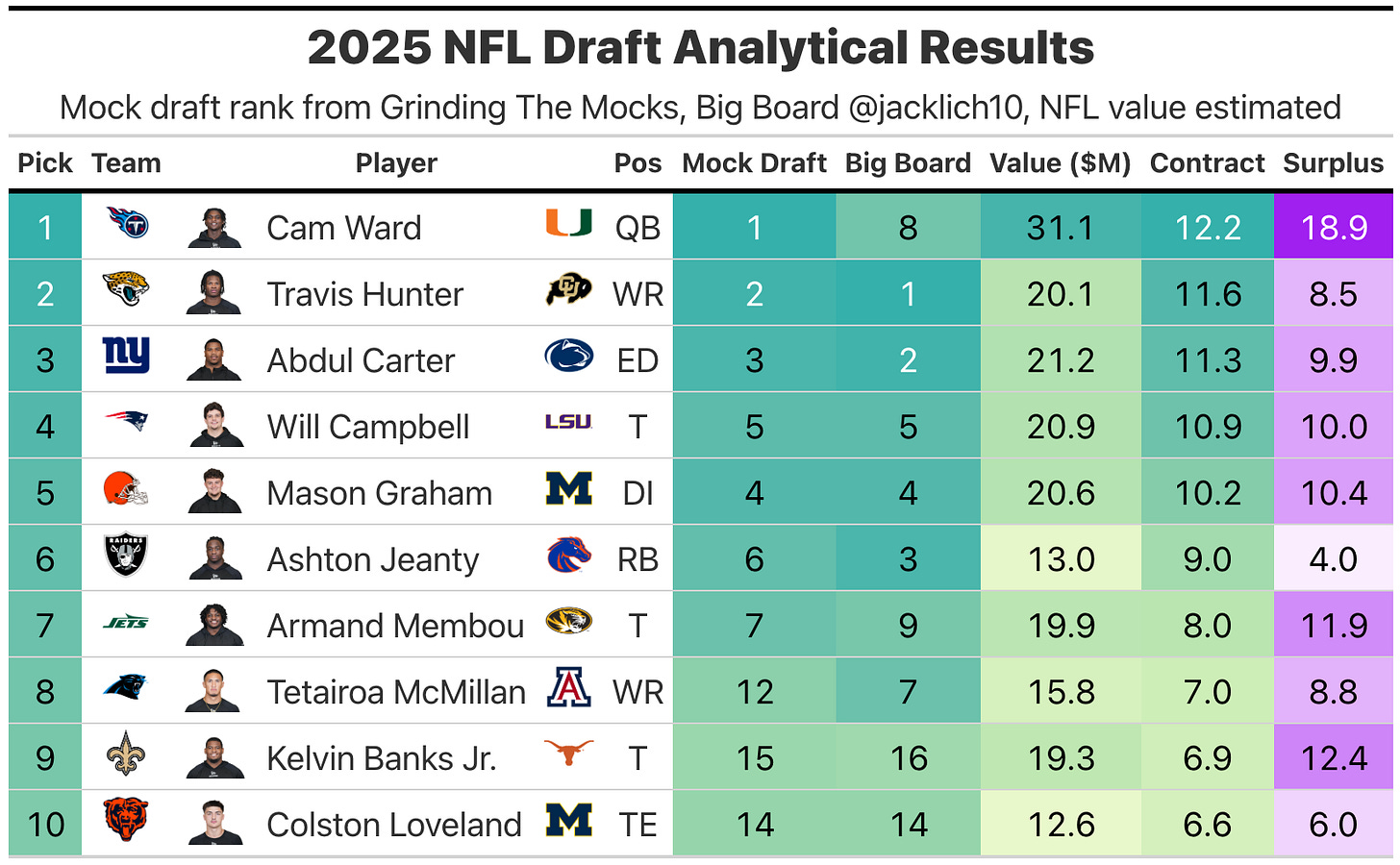2025 NFL Draft First-Round Analytical Review
Using consensus data from mock drafts and big boards, plus surplus value considerations, to analyze the first round of the NFL draft
We’ve finally gotten to and finished the first round of the NFL draft. There will be a ton of content hitting the streets in the next 12 hours to tell you the feeling and opinions on which teams made the best use of their draft capital.
In this post, I eschew the vibes-based analysis that dominates NFL media and judge the first round on explicit metrics that matter. I leveraged the excellent weighted mock draft data from Grinding the Mocks and consensus media Big Board data aggregated from Jack Lichtenstein on his beautifully website. In addition, I estimated the NFL value and subtracted the contractual commitment of each pick to determine the player’s surplus value, or value you’d have to pay in free agency over what the rookie contract demands. I went through this exercise earlier this month building a more useful Big Board using Sports Info Solutions draft grading and positional contract data from Over the Cap.
2025 NFL Draft Analytical Big Board
* Subscribe to get all of the Unexpected Points content, including precise draft grading and analysis for every team
Let’s get to the data. The first section below has a table with a row for every pick. It has the pick number, the mock draft-based estimated draft position, the consensus big board ranking, and the estimated values of the prospect, his contract amount and the surplus value to the team. I also have a plot showing the differences better the actual pick numbers and the consensus opinions on mocks and big boards. Let’s get to the data.
TOP-10 PICKS OF THE ROUND
The “Value” number is my estimate for salary cap equivalent for the player based on positional value and historical trends for prospects taken at his draft slot. Contract is the annual amount due, and surplus value is the difference that the team gains acquiring the player through the draft.
Outside of a major trade, things went according to plan early in the draft. But the trade was a major deal, especially considering that it was for a non-quarterback. The Cleveland Browns gave up the second overall pick, along with their fourth (104) and sixth round picks (200), and received the Jacksonville Jaguars’ No. 5 pick, second (36) and fourth round picks (126), plus a 2026 first-rounder. This will give the Browns a huge surplus value boost (roughly $50 million). I’ll detail trade gains/losses more in my post-draft grading analysis.
The “Value” assumptions for each player are based on historical averages at their positions, so the specific numbers reflect whether the players taken were better or worse values than we’ve seen in the past. Cam Ward, like any early quarterback pick, is a huge value, offset somewhat by the fact that designated rookie contract values at the top of the draft are so much higher.
Travis Hunter’s value is a little suppressed as a WR/CB, with those positions not being quite as valuable as “tier 1” positions (OT and DL). Positional value is rising for wide receivers, so Hunter gets a boost from the assumption he’ll play some on offense. What the numbers don’t reflect is Hunter playing both ways and adding the value of multiple players at the same time. We just haven’t seen any players in the modern era play both ways for a significant period of time. I’m still in “believe it when I see it mode” before redefining the modeling for a single “unicorn” player.
Abdul Carter as an edge rusher has a higher surplus and overall value number. Even so, the highest average surplus value assumptions come near the end of the top-10, with Kelvin Banks Jr. topping the list, being a tier 1 offensive tackle and only commanding an annual salary of $6.9 million per season.
The two noticeable lulls in value come in the forms of Ashton Jeanty and Colston Loveland. Tight ends and running backs fall into tier 3 and tier 4, respectively, in assumed NFL value. Simply stated, NFL front offices haven’t valued those positions nearly as much as others, and the first-round hit rate, especially at tight end, hasn’t been high enough to justify taking the positions this early. Last year’s breakout rookie Brock Bowers hasn’t played long enough to affect the model, so perhaps Loveland is a bit undervalued.
REST OF THE FIRST ROUND
Keep reading with a 7-day free trial
Subscribe to Unexpected Points to keep reading this post and get 7 days of free access to the full post archives.







